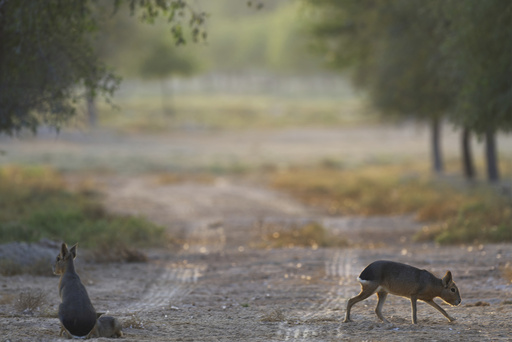
Patagonian Maras Thrive in Dubai’s Al Qudra Lakes
Nestled within the expansive sand dunes of Dubai, a hidden desert oasis known as Al Qudra Lakes has unexpectedly welcomed a curious influx of travelers—specifically, a group of Patagonian maras, which are unique rodents resembling a mix between rabbits and hoofed animals. These creatures now explore the picturesque grounds typically inhabited by local wildlife, such as gazelles.
The origin of these maras remains unclear, creating intrigue in a nation where exotic animals sometimes find their way into affluent homes and private farms. Notably, these rodents have adapted to their new environment and established a stable population over several years within the network of burrows hidden among the dunes.
Neither the Climate Change and Environment Ministry of the UAE nor Dubai authorities have provided comment regarding the presence of Patagonian maras. Estimates indicate there could be as many as 200 maras living in this area and the adjacent Al Marmoom Desert Conservation Reserve, given that only a handful of deceased maras have been observed.
During a recent excursion to Al Qudra Lakes, a journalist discovered at least five maras, with subsequent visits revealing several packs, including one mother nursing her young. Al Qudra Lakes is located approximately 40 kilometers (25 miles) from downtown Dubai and is known for its long bicycle tracks that attract outdoor enthusiasts during the milder winter months. The region features a series of manmade lakes, some uniquely shaped to promote Dubai’s attractions.
The Patagonian maras were first reported in public in 2020, coinciding with the COVID-19 pandemic. Their sightings garnered attention in the summertime issues of the Dubai Natural History Group’s newsletter, detailing occurrences both at Al Qudra and on Saadiyat Island near Abu Dhabi.
According to mammal expert Jacky Judas, this large rodent likely escaped from captivity, as they are commonly found in zoos. He noted how they could be spotted resting or foraging for grass in the middle of traffic roundabouts at Al Qudra. Although not specifically suited for arid environments, the absence of natural predators like pumas may allow Patagonian maras to survive in areas enhanced with tree plantations, lawns, and ponds.
The environment of Al Qudra appears to be aiding their survival, even in the face of harsh summer temperatures exceeding 45 degrees Celsius (113 degrees Fahrenheit). Signs suggest thriving reproduction, as Patagonian maras mate for life and females have limited mating opportunities of short duration. They can give birth to one to three young per cycle. In their native Argentina, they face threats from hunting and are sometimes used for their fur.
Patagonian maras are herbivorous and don’t pose any dangers to humans; however, they may face few predators in Al Qudra, with Arabian red foxes existing in the vicinity. The mystery of how these rodents arrived at Al Qudra endures. While they are on display at Dubai Safari Park, the distance to the lakes is not far from the urban center.
Nearby luxury farms owned by Dubai’s elite suggest the possibility of escape, either by wandering off or digging through fences. In the past, Patagonian maras have been imported as exotic pets, which has raised issues elsewhere. Recently, in Colorado, a mara was the subject of local media attention before its suspected death. Additionally, one was discovered in a car trunk during a trafficking attempt from Greece to Turkey.
Although the Emirates prohibits the ownership of endangered wildlife as pets, incidents of exotic animals being kept have occurred, as evidenced by numerous social media posts showing Emirati men cruising with lions. In 2021, authorities issued warnings about a “wild cat” spotted roaming a neighborhood.
